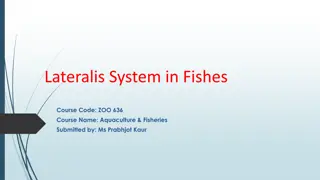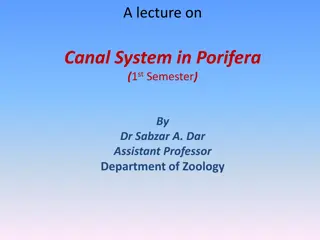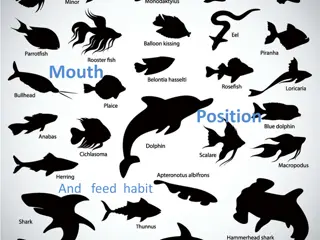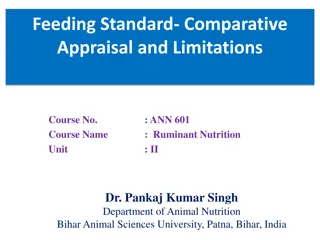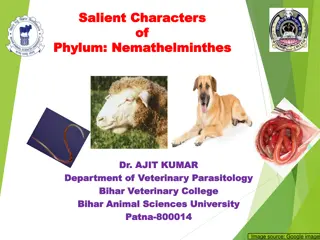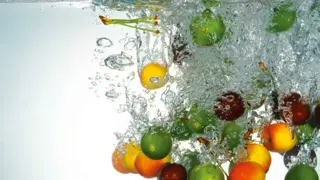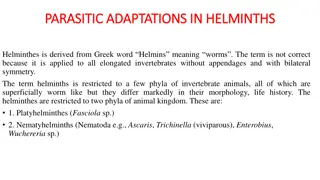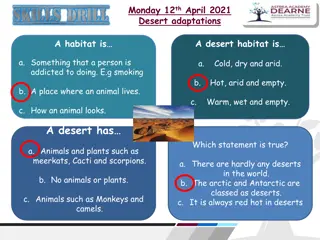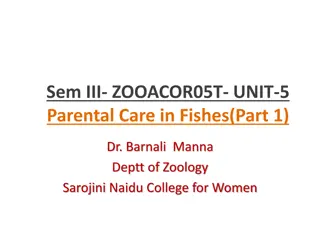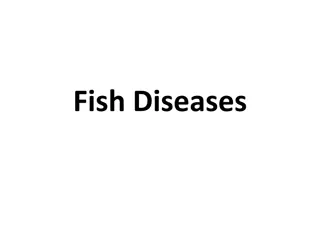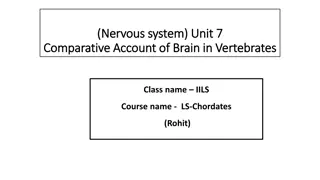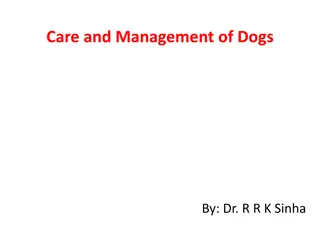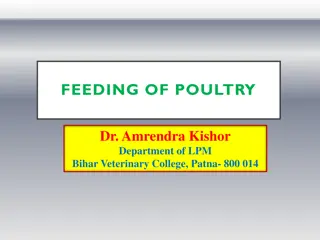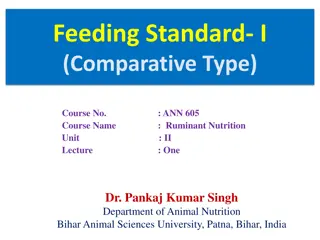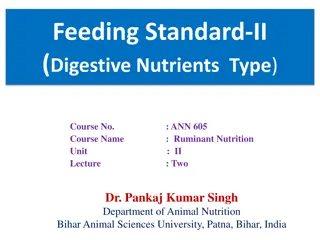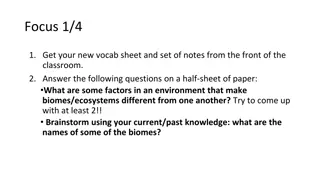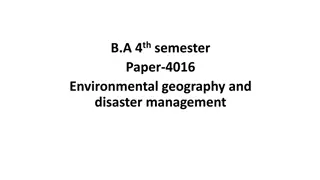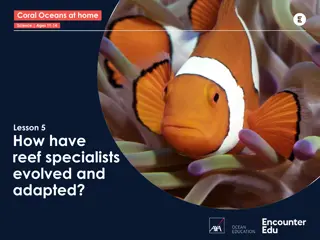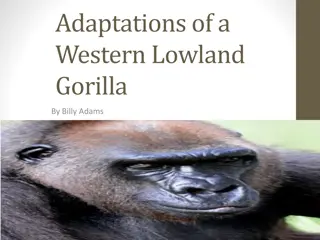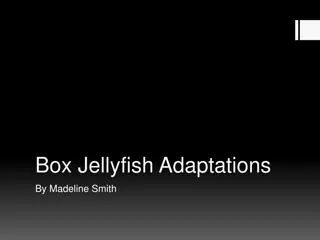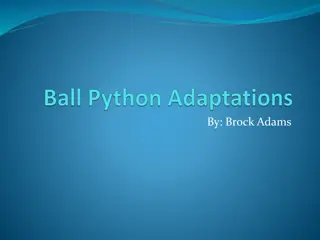Alimentary Canal and Feeding Adaptations in Fishes by Dr. Sunitha A. Philip
The presentation discusses the alimentary canal and feeding adaptations in fishes, covering topics like the different regions of the gut, mouth types in fish, adaptation of teeth for specific diets, and the roles of the buccal cavity, pharynx, and gill rakers. It further explores how gill rakers vary in omnivorous, herbivorous, and carnivorous fishes, showcasing the diverse feeding strategies in the aquatic world.
Download Presentation

Please find below an Image/Link to download the presentation.
The content on the website is provided AS IS for your information and personal use only. It may not be sold, licensed, or shared on other websites without obtaining consent from the author. Download presentation by click this link. If you encounter any issues during the download, it is possible that the publisher has removed the file from their server.
E N D
Presentation Transcript
Alimentary canal and feeding adaptations in fishes Dr.Sunitha A.Philip
Introduction Digestive system includes alimentary canal and associated glands.Alimentary canal or gut shows four distinct regions. 1. Ingressive zone 2. Progressive zone 3. Degressive zone 4. Egressive zone MOUTH OESOPHAGUS STOMACH INTESTINE RECTUM
Mouth Mouth is the anterior opening of alimentary canal . Most fish mouth fall into three general types: 1 . Superior mouth type 2. Terminal mouth type 3. Inferior or sub terminal mouth type
Teeth Teeth are generally hollow cones of dentine containing the pulp cavities. Absence of teeth in case of cyprinoids ,which have got pharyngeal teeth instead of normal teeth which are adapted for crushing & grinding the prey . Pharyngeal teeth are located below & above pharyngeal arches.
Teeth adapted for crushing hard shell of mollusks & crustaceans
BUCCAL CAVITY, PHARYNX & GILL RACKERS The buccal cavity and pharynx are not clearly marked off fromeach other. Anumber of perforations of gill slits are located on each side of pharyngeal wall. the Primary function of the gill rakers is to protect gill filaments from injury and to assist the fishes in the process of ingestion .
OMNIVOROUS In the omnivorous fishes like Puntius sarana,gill rakers are short and stumpy. HERBIVOROUS: In Labeo rohita,Cirrhina marigala,gill rakers form a broad sieve like structure across the gill slits for filtering the water in order to retain the food in the bucco- pharynx
Carnivorous Fishes : Gill rakers are normally long, hard and teeth like forming rasping organs as in Wallago attu, Mystus seenghala, Channa striatus.
Oesophagus The pharynx opens behind into the oesophagus which have large number of mucus secreting cells which are scattered in the mucosa. Taste buds are also present e.g. Labeo rohita,c.carpio,catla catla Short & narrow tube in case of herbivorous and omnivorous fishes e.g. Labeo rohita,Puntius sarana, Cyprinus carpio etc Large & distensible tube in case of carnivores and predatory fishes (e.g. Wallago attu, H. fossilis etc
Stomach Stomach acquire different shapes according to the availability of space in the body cavities of different fishes. ANTERIOR CARDIAC STOMACH STOMACH POSTERIOR PYLORIC STOMACH All the fishes do not possess a true stomach as it is almost absent in various herbivorous fishes like Labeo rohita,Catla catla etc. In such fishes, the anterior part of the intestine is swollen to form a sac like structure called intestinal bulb. A true stomach is present in the carnivorous and predatory fishes e.g. Channa striatus, Mystus seenghala etc .
Carnivorous fishes: Stomach is generally sac-like and thick walled in Carnivorous and predatory fishes. Omnivorous fishes: Stomach of omnivorous fishes is also sac like .e.g. Puntius sophore,Cyprinus carpio etc. In some fishes like Hilsa hilsa,Gudusia chapra, stomach is reduced in size but is greatly thickened to become gizzard like for trituration of food
Pyloric caeca Anterior part of the intestine give rise to a number of finger-like outgrowths called pyloric or intestinal caeca. Pyloric caeca serve as accessory food reservoirs . Histologically, intestinal caeca resembles the intestine and probably serve to enhance the absorptive area.
Intestine The part of alimentary canal that follows the stomach is called intestine and is divided into two parts: 1. Anterior part : small intestine 2. Posterior part : large intestine The small intestine just behind the stomach receives ducts from the liver and pancreas is called as duodenum while rest part is called ileum . There is no clear cut demarcation between the small intestine and large intestine . The length of the intestine depends upon the feeding habit of the fish.
Carnivorous fishes : It is shortened in carnivores such as in Wallogo attu, Mystus seenghala because flesh can be digested more readily than the plant based food stuff.
Herbivorous fishes: Intestine is often elongated and arranged in many folds in case of herbivorous fishes. Longer intestines are of great advantage to herbivorous fishes as they retain food for long period of time to ensure digestion.
Omnivorous fishes: Intermediate length is found in case of omnivorous fishes e.g. Puntius sophore etc. The intestinal bulb of Rohu is about 25cm,the small intestine about 8m and the large intestine about a meter in length.
Rectum It is not usually distinguishable externally but an ileo- recta valve is present in few species of fish to demarcate it from the intestine e.g. Tetradon Histologically ,the mucosal folds of the rectum differ from the intestine in being shorter and broader, possess a large number of mucus secreting cells produce copious mucus to lubricate waste food and aid in easy defecation
Digestive glands Two main digestive glands : 1 . Pancreas: pancreas is a diffuse gland, but is well developed around the blood vessels between the lobes of the liver. Pancreas has two digestive functions: 1. Source of exocrine secretion into the intestine. 2. Endocrine secretion of the hormones insulin and glucagon . 2.Liver: Liver is a bilobed gland usually yellowish brown in color. The liver in fish produces bile which is stored in the gall bladder. Key storage of food energy in the form of glycogen.
Digestive enzymes Pepsin Trypsin Chymotrypsin Elastase Carboxypeptidase Aminopeptidases Pancreatic alpha amylase Colipase Pancreatic lipase Cholestryl ester hydrolyase Ribonucleases Deoxyribonucleases
Feeding adaptaions in fishes Various structures have been modified according to the nature of the food and feeding habits of the fish. Position and shape of the mouth. Dentition. Lips may become or papillated. Taste buds and mucus secreting cells . Structure of pharynx and gill rakers modifications according to the feeding habit of the fish. Relative length of the gut (RLG). cornified as in case of Labeo ,granular have also undergo
The structure of the alimentary canal varies in different species of fishes,and is generally adapted in relation to the food and feeding habit. The variations are seen in the position of the mouth,architecture of the buccopharynx ,relative length of the gut,presence or absence of the stomach and pyloric caecae.
http://www.google.in www.yourarticlelibrary.com www.earthlife.net/fish/digestion.html/ Textbook of fish physiology by HOAR Textbook of fish biology and fisheries by S.S.KHANA,H.R.SINGH



